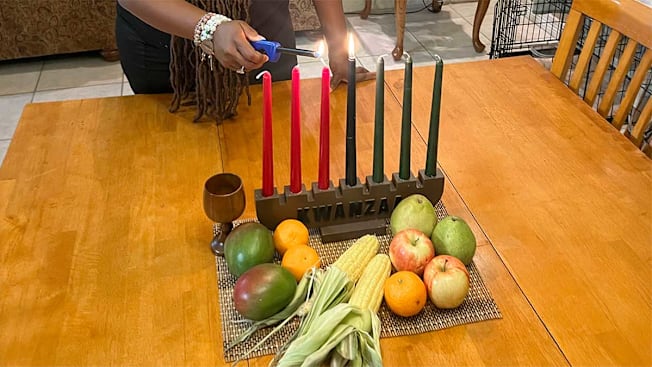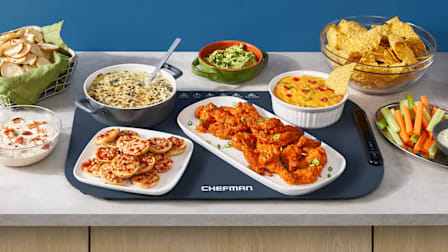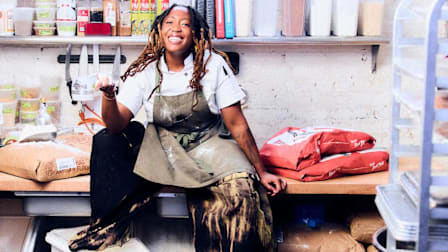How to Celebrate Kwanzaa
This cultural holiday features seven principles that help people become intentional about their thinking, their path, and more
When you shop through retailer links on our site, we may earn affiliate commissions. 100% of the fees we collect are used to support our nonprofit mission. Learn more.

“What’s Kwanzaa?,” my daughter, then 11 years old, asked on Christmas Day in 2016 after noticing my Aunt Jennifer’s Kwanzaa altar in her home in South Miami, Fla.
That question prompted my aunt to quickly whip her head around. With a shocked expression on her face, she asked me: “I thought you were in Jack and Jill. Why doesn’t she know about Kwanzaa? Don’t you celebrate Kwanzaa?”
What Do You Need for Your Kwanzaa Altar or Table?
Kwanzaa celebrations look different in each family. Some people celebrate all seven days; others wrap the celebration into one day. A Kwanzaa altar or table display typically includes:
• A mat (Mkeka), which symbolizes present and ancestral work.
• A unity cup (Kikombe cha Umoja) used to perform a ritual with libations.
• Crops (Mazao), which include favorite fruits and vegetables that are intended to help people celebrate the fruits of their labor.
• A candleholder (Kinara).
• Seven candles (Mishumaa Saba).
• Corn (Muhindi), a symbol of children and the family’s future.
• Gifts (Zawadi).
The 7 Principles of Kwanzaa
Umoja is the first one, and it means unity. According to the International African American Museum, Umoja emphasizes the importance of togetherness for the family and the community, reflecting a belief that strength stems from unity.
Carolyn Murray, a retired psychology professor at the University of California, Riverside, used to open her home for community Kwanzaa celebrations. Umoja is one of her favorite Kwanzaa principles. “We need to educate our kids about being unified and about loving ourselves and loving each other, so unity is my favorite,” she says.
Kujichagulia means self-determination, and it is the second principle of Kwanzaa and my personal favorite. Sharron Lewis-Campbell agrees with me. She is a lifetime member of Jack and Jill of America and the CEO of Empower-You Edutainment, an organization whose mission is to uplift African American youth.
“Like I tell my daughter all the time, you just can’t let obstacles stand in your way. You gotta be determined to make it,” Lewis-Campbell says. “And so with the principle of Kujichagulia, it’s given us the opportunity to find ourselves, and that’s important because all the time people are trying to tell us who we are.”
Ujima is the third principle and means collective work and responsibility. Valecia Tizeno, another member of Jack and Jill of America, began learning more about Kwanzaa when she attended Howard University in Washington, D.C. She started celebrating Kwanzaa with her son when he was 2 years old; he’s now 13. She says Ujima teaches people to work together.
“Letting everyone know that they have a duty to help other people, that you have to take responsibility for what goes on in your community,” Tizeno says. It’s important to partner with other people to try to get things done and solve problems as well.
Ujamaa is the fourth principle of Kwanzaa and means cooperative economics. It stresses supporting Black-owned businesses.
“You know, there’s an old saying: You have to sweep around your own front door,” Tizeno says. “And so we have to make sure that our communities don’t fall apart.”
She continues: “I think now more than ever that it’s important because in a lot of our African American neighborhoods, there’s a lot of economic decline, and I think it’s important to look at this particular principle because we have to build things back up.”
Nia means purpose and is the fifth principle. Both Jack and Jill members Mikn Simon and Lewis-Campbell named their daughters Nia.
“What is our purpose?” Lewis-Campbell says. “So when I talk to God, because I am a believer, I ask the Lord, what is my purpose? What should I do? And then, in return, He connects me with my passion.”
“As it relates to Kwanzaa, it’s just having purpose” within the African American community, Simon says. “Our purpose for celebrating Kwanzaa is for us to connect with our culture as well.”
Kuumba is the sixth principle of Kwanzaa and means creativity. Lewis-Campbell believes it’s within all of us.
“For example, when you think about our ancestors and when they were being enslaved and they were in the fields, what did they do? They sang, you see what I’m saying?” she says. “So creativity is us; it is who we are, and we have to be able to use our creativity to be successful.”
Imani means faith and is the final principle of Kwanzaa. Lewis-Campbell believes individuals cannot make it without faith.
“We’re going to have obstacles, but in order to climb that mountaintop and get there, we have to have faith and see ourselves there before we even get there, and so Imani is so important,” Lewis-Campbell says. “When you look at all the principles, the way they were meant for us to use them, it’s not for just the seven days. It’s a year-round journey.”
Tips on Hosting a Kwanzaa Celebration
“I really believe that these are the most important principles in any person’s life, whether they’re Black or whatever color they are,” Murray says. She thinks that all cultures can benefit from celebrating Kwanzaa.
Tizeno sees Kwanzaa as a way to mentally prepare for the new year. “I think it helps you to kind of reset as you get ready for the new year because the last day of Kwanzaa is Jan. 1. So it’s kind of like leading out of Christmas, the days after Christmas; you have an opportunity to reflect on things that are important,” she says.
Whatever your purpose is for celebrating, here are some tips for the holiday along with product recommendations:
Kwanzaa Kinara Set
You should prepare your Kwanzaa altar or table display before the celebration. Amazon, Etsy, and Bed Bath & Beyond are just some of the retailers that sell Kwanzaa sets. This Amazon Kwanzaa set is around $30 and is basically Kwanzaa in a box. According to the product description, it comes with a Kwanzaa candleholder, seven candles (three red, one black, and three green), a wooden wine cup, and a bamboo table mat. You will need to add the fruit, nuts, vegetables, and corn. The set is available at Amazon.
Vinada Sparkling Rosé Zero Alcohol Wine
Every Kwanzaa celebration should start by paying tribute to your ancestors with a libation ceremony. Look for scripts and videos online that you can follow.
Consider using a festive nonalcoholic wine so that everyone can be included. This bubbly and fruity CR Editor’s Choice will pair well with your Kwanzaa meals. In my household, we pass out small individual cups so that everyone can take a sip in unison at the end to symbolize unity. Available at Amazon.
iLevar Dual Arc Lighter
Children are encouraged to participate in Kwanzaa celebrations each year. Simon’s daughters, 5 and 8 years old, enjoy lighting the candles.
“With Kwanzaa, because it’s not as commercialized, it’s a lot easier to present just the purpose of it to them,” she says. “And it’s a little bit harder for them to remember—to be honest with you—some of the principles of it because it’s not as commercialized, but they remember the rituals. They remember the Kinara, the candleholder. They remember the candles being lit.”
Consider using a plasma lighter during this portion of the celebration. It’s not as dangerous because there’s no big flame. And there are safety features built into the iLevar Dual Arc Lighter that are helpful. I personally use a regular lighter because my children are older and I love to see a big flame. Available at Amazon.
Piecework Cin Cin 1,000-Piece Puzzle
Every Kwanzaa celebration has an educational element. The National Museum for African American History and Culture has Kwanzaa videos for kids that teach each principle paired with activity sheets, coloring pages, and a Kwanzaa book list.
“We can create something,” Simon says. “We get crafty, and they love doing that and having a hands-on activity. They could actually give a gift to someone else and have those principles come out.”
“I think it teaches kids a lesson, you know, about how to respect other people and how to just be grateful,” Tizeno says. “And it’s something you can carry over, you know, into your daily life."
It may also be a good idea to put a puzzle together as a family. This colorful Cin Cin puzzle pieces together the perfect feast. This is something the entire family can participate in throughout the seven days of Kwanzaa and gives family members a break from electronics, encouraging conversation and reflection. Available at Piecework Puzzles.
8-qt Digital Air Fryer Cream by Tabitha Brown for Target
Typically, a large feast called Karamu occurs on the sixth day of Kwanzaa. You can find several recipe ideas for it online.
“What I always like to have in my Kwanzaa celebration is black-eyed peas and rice because you know, black-eyed peas come from Africa,” Lewis-Campbell says. “And I like to have yams.”
“Sometimes it’s fried chicken, and a lot of times it’s greens, it’s black-eyed peas,” Simon says. “It’s what a traditional dinner sometimes looks like on New Year’s Day.”
Consider using the CR Recommended 8qt Digital Air Fryer by Tabitha Brown for Target to prepare your meal. According to the product description, this digital air fryer also roasts, crisps, dehydrates, keeps food warm, and reheats. It comes with a ceramic nonstick tray and an additional silicone baking tray, and it has a temperature range of up to 400º F.
“I wish more families explored it and got to know what Kwanzaa is really about so that they could see that it’s worth celebrating,” Simon says.




















